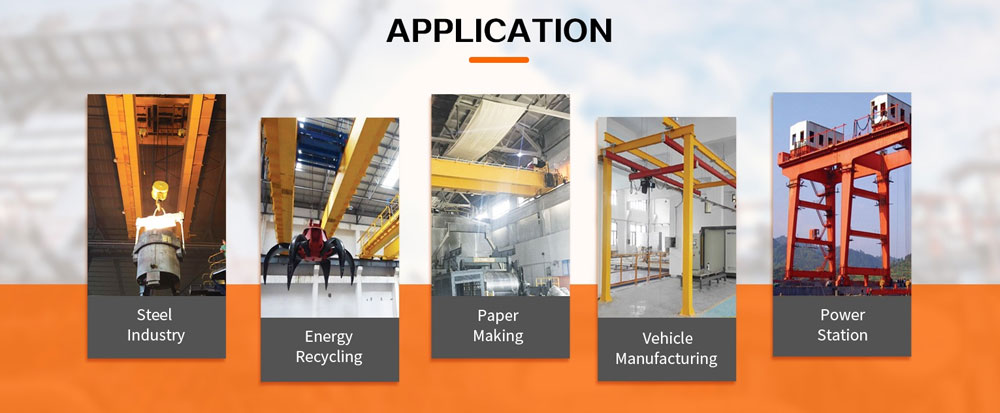WhatsApp: +8619037303916
Email: [email protected]
WhatsApp: +8619037303916
Email: [email protected]
Overhead cranes are hoisting equipment that is horizontally placed over workshops, warehouses and stockyards for material hoisting. Because its two ends sit on tall concrete columns or metal supports, it is shaped like a bridge. The bridge of the bridge crane runs longitudinally along the track laid on the elevated on both sides, which can make full use of the space under the bridge to lift materials without being hindered by ground equipment. It is the most widely used and the largest number of hoisting machinery.
Many industries rely on cranes to do their jobs safely and efficiently. Industrial overhead cranes have many applications even within individual industries. Using a non-removable overhead crane is a great solution if you are dealing with large, heavy or hazardous items, or when working in locations that require immediate immobilization of damaged machinery.
So, what fields are overhead cranes mainly used in? In Kinocranes' view, there are currently six categories of industrial overhead crane applications.

Electric overhead traveling (EOT) cranes are used in the above 6 industries for material handling within a fixed span. To meet industry needs, overhead cranes can be categorized into several types based on their use and lifting devices:
1. Hook Overhead Crane
Suitable for general loading, unloading, and lifting transport work in factories, enterprise workshops, warehouses, both indoors and outdoors with a fixed span. The commonly used duty classes range from A3 to A7. A3-A4 are used for equipment installation and maintenance, A5 for mechanical processing, metal structures, assembly, and A6-A7 for busy conditions or frequent full-load operations. These cranes are not suitable for lifting flammable, explosive materials, or hot liquid metal.
2. Grab Overhead Crane
Used in metallurgy, chemical, cement, and other enterprises' warehouses and workshops for handling bulk materials like ore, limestone, coal, sand, etc., in fixed spans indoors or outdoors. The grabbing device is a four-rope grab with double drums. The grab can open and close at any height; for material chunks larger than 60mm, a toothed grab should be used.
Grabs are only suitable for naturally piled bulk materials; special instructions are needed when grabbing underwater materials.
The rated lifting capacity of the grab overhead crane includes the weight of the grab itself and the weight of the lifted material.
3. Electromagnetic Overhead Crane
Equipped with a detachable electromagnetic disk, it's suitable for busy loading, unloading, and transporting of ferrous metal products and materials with magnetic properties in metallurgical plants. The electromagnetic disk is powered directly by a cable reel on the trolley. The rated lifting capacity of the electromagnetic overhead crane includes the weight of the electromagnetic disk and the lifted material.
4. Dual-Purpose Overhead Crane
Divided into grab-electromagnetic and grab-hook types to improve production efficiency; a hook and grab or an electromagnetic disk and grab are installed on the same trolley. However, only one type of lifting device can be used per work cycle.
5. Triple-Purpose Overhead Crane
A crane with a detachable electromagnetic disk, motorized grab or gravity grab, and hook is called a triple-purpose crane. The three lifting devices can be interchangeably used to transport finished products, bulk materials, or magnetic metal materials. Only one type of lifting device can be used at a time.
6. Explosion-Proof Hook Overhead Crane
Explosion-proof cranes are suitable for workshops and warehouses with flammable and explosive gas mixtures for general transport operations. There are two main categories according to JB/T5897 standards: Category I for mining cranes and Category II for factory cranes. These cranes have explosion-proof electrical equipment and corresponding mechanical explosion-proof measures to prevent sparks that could cause combustion or explosion accidents during operation. All explosion-proof electrical equipment is marked with "EX." The explosion-proof level of the crane should be selected according to the classification of hazardous substances, represented as levels Ⅰ, ⅡA: ⅡB, ⅡC (Category I uses voltage 660V-1140V, Category II uses voltage 380V). Factories commonly use level ⅡB or ⅡC (ExdⅡBT4、Exd ⅡCT4).
7. Insulated Hook Overhead Crane
Suitable for electrolysis workshops such as aluminum and magnesium to prevent current from passing through the electrically charged components being lifted to the crane during operation, endangering the life safety of the operator. Several insulation devices are set at appropriate parts of the crane, typically three layers, known as insulated cranes. Each layer has an insulation value of ≥1MΩ.
8. Double Trolley or Multi-Trolley Overhead Crane
A crane with two or more trolleys; their lifting or running mechanisms can be designed to operate either in conjunction or independently as per user requirements. The total lifting capacity is executed according to contract specifications; it can be the sum of the main hook lifting capacities of each trolley or just one of them.
9. Casting Crane
Suitable for smelting workshops for lifting high-temperature liquid metal. Common structural forms include four main beam double trolley structures and double main beam single trolley structures (with primary and auxiliary hooks). The main hoisting mechanism has dual-drive mechanisms (mostly used for large tonnage cranes) and single-drive mechanisms (mostly used for small tonnage cranes).
10. Mobile Cab Overhead Crane
For accurate operation by the driver, the crane's cab can move along the bridge with the trolley or move independently along the main beam. Mainly used for cranes with extra-large spans.
The above information is provided by Kinocranes, which has over 10 years of experience. If you require any product or material handling solution, please contact our experts ([email protected]), and we will provide you with a solution within 24 hours.
TO TOP